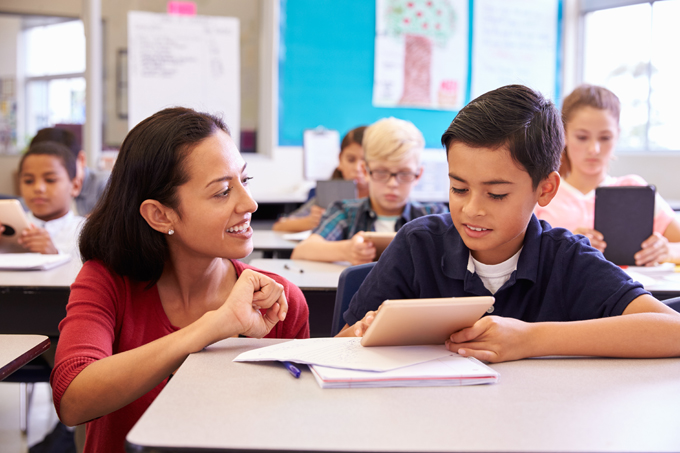 In today’s K–12 classrooms, students are learning to code using a variety of apps, software, and technologies. My 4-year-old daughter even has her own robot, which she codes by selecting emojis on the Coji app to control the robot’s movement. As a teacher educator, I believe it is my responsibility to provide future educators with hands-on technology and literacy experiences to prepare them to teach tomorrow’s students.
In today’s K–12 classrooms, students are learning to code using a variety of apps, software, and technologies. My 4-year-old daughter even has her own robot, which she codes by selecting emojis on the Coji app to control the robot’s movement. As a teacher educator, I believe it is my responsibility to provide future educators with hands-on technology and literacy experiences to prepare them to teach tomorrow’s students.
Because of this stance, I designed and implemented an activity that integrates robotics into literature circles. My fourth graders would have been overjoyed to complete this activity, and my current students (future educators) agree that this activity should be included in their future classrooms.
Capturing interest begins with book choice
For valid pedagogical reasons, we often waver between forming heterogeneous or homogeneous student groups in the classroom. I implement literature circles with the goal of creating enjoyable reading experiences. One way I do this is by allowing students to choose their own books, within mature and sensible guidelines (e.g., recommended reading and maturity levels).
My students express gratitude for this strategy because “by being able to choose our own book, we were more interested and more excited to participate in this project.” Most confess this is the only time in their college career when they are encouraged to read a book of their choice. By allowing my students to choose their own reading material, my hope is that they will model a positive attitude toward reading for their future students.
A classroom example
After my students spend about three weeks reading and discussing their literature circle books, the excitement builds as they construct a 3-D diorama to represent their favorite scene from the book. During construction, students carefully consider which parts they want to make move or illuminate. We use everyday materials such as cardboard, paper, paint, scissors, tape, markers, and string.
Once the dioramas are complete, the next step is to prepare your classroom to teach coding. For the initial setup, I recommend getting support from your librarian or technology specialist. You will need a laptop, power cord, and robotics kit. We used Hummingbird Robotics because the kits are affordable and the compatible coding software is free and user friendly.
With the software installed, you are ready to teach students how to code. An important step is to distribute the robotics kits so you can pause and answer students’ questions while allowing them to explore the technology. There are many tutorials available, but I recommend identifying one that aligns to your compatible robotics kit. For this reason, I guide my students with the Hummingbird Robotics and Scratch 2.0 tutorial, available here. During this lesson, allow your students to explore how they can use the laptop to drag, drop, and create a coding sequence. Options include the ability to guide directional movement (e.g., turn 360 degrees), adjust speed, play audio features (e.g., a cat’s meow), and activate LED lights of varying brightness.
Now that students have learned the basics of coding, they are ready to connect the robotics kit to their dioramas. Refer to the video tutorial to remind students how to connect their laptops to their bit controller (i.e., circuit board) and have students attach the servos and/or LED lights to their dioramas. This reminder will help students bring their dioramas to life as they connect the motors and LED lights to their 3-D model according to the code they generated.
Once connected, students might see a hand waving 90 degrees on repeat, a character spinning in a circle, or an object moving back and forth. You will know the exact moment the dioramas come to life when you hear students shouting in awe at their designs (refer to our robotics diorama example videos and images).
Robotics diorama examples
Following are the dioramas students created:
Envisioning literacy and robotics in your classroom
Although nearly all my students had no prior experience coding with robotics, they admit this process “is not too complex” and “gives students the opportunity to explore different career fields as well as encourages hands-on learning.”
After students have some experience coding with robotics, you might consider how this technology can advance other aspects of literacy within your classroom. You can browse available lesson plans at here. Additional lesson ideas might include researching countries and creating related dioramas or having students create digital stories using scratch coding. The most exciting aspect about using robotics within literacy is the ability for students to expand their imagination—how will your students use coding and robotics to bring literacy alive?
Lauren Eutsler, an ILA member since 2010, was an elementary teacher in Arizona and Florida for six years before her current role as an assistant professor of literacy and technology in the department of teacher education and administration at the University of North Texas.